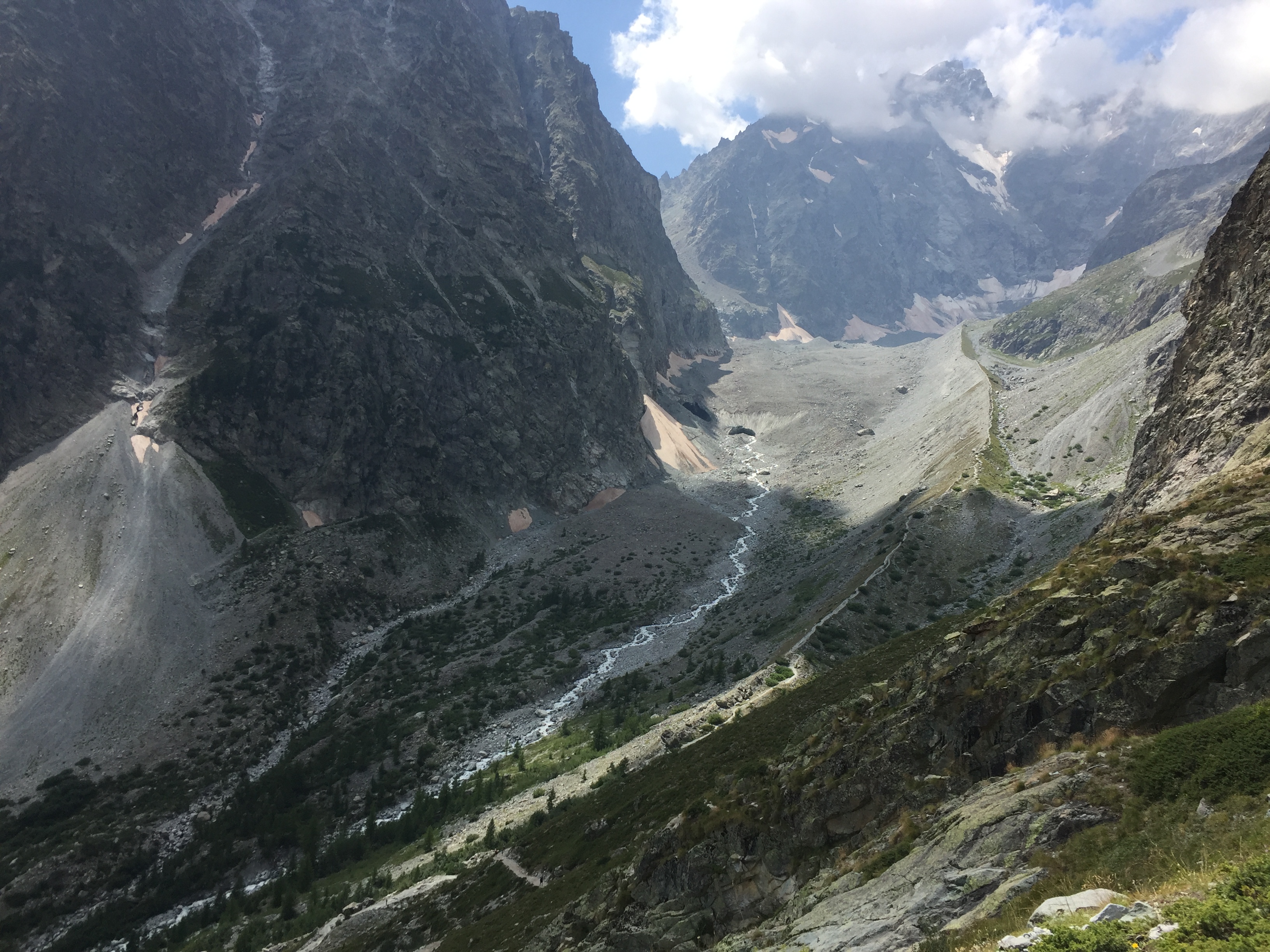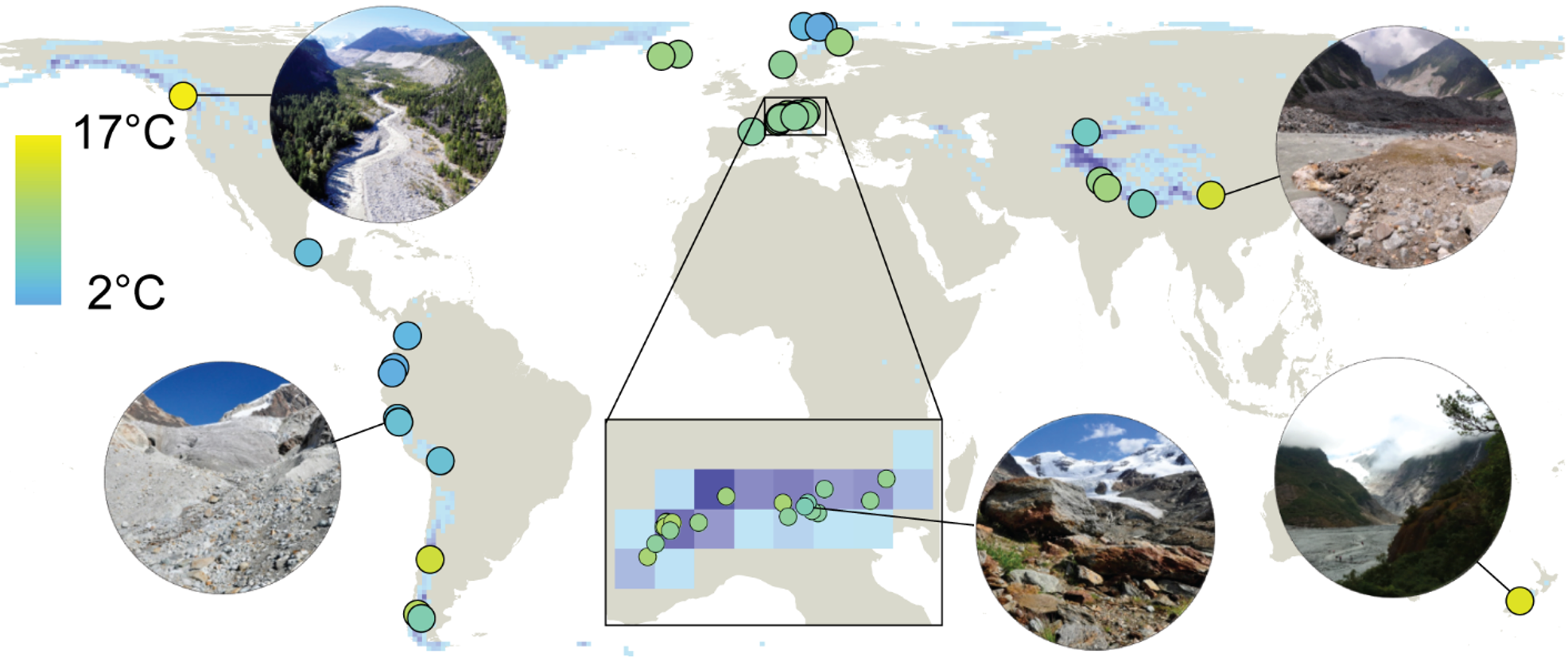The project
Reconstructing community dynamics after glacial retreat to better understand biotic interactions and ecosystem functioning
Context
Glaciers are retreating all over the globe. Increasing areas are exposed and colonized by multiple organisms, but lack of global studies hampers a complete understanding of the future of recently deglaciated terrains. What will be the fate of these areas? How do animals, plants and microorganisms colonize them? How do they interact to perform successful colonization? Which are the processes determining colonization patterns? How does ecosystem functioning evolves through time? Until now, the complete reconstruction of soil communities was hampered by the complexity of identification of organisms, thus analyses at broad geographical and taxonomic scale have been so far impossible.

Biotic colonization following the retreat of the Glacier noir in the Alps.
This project combines innovative methods and a global approach to boost our understanding of the evolution of ecosystems in recently deglaciated areas. We are investigating chronosequences ranging from recently deglaciated terrains to late successional stages of soil pedogenesis, exploiting the power of environmental DNA metabarcoding.

Related studies
- Guerrieri et al. 2022. Metabarcoding data reveal vertical multi-taxa variation in topsoil communities during the colonization of deglaciated forelands. Link
- Cantera et al. The importance of species addition versus replacement varies over succession in plant communities after glacial retreat. Preprint
- Marta et al. Heterogeneous changes of soil microclimate in high mountains and glacier forelands. Preprint
Mycorrhizal community dynamics and drivers after glacier retreat across the globe
Aim: Mountain and high-latitude glaciers have been retreating around the world since the Little Ice Age. Large areas of deglaciated substrates are exposed to soil development and there is an urgent need to predict their evolution. Ecosystem development in these nutrient-poor and harsh environments is limited, with primary production heavily dependent on mutualisms such as arbuscular mycorrhiza and ectomycorrhiza, the two most widespread plant-fungal symbioses.
Method: To explore the dynamics and drivers of mycorrhizal fungi, we conducted a comprehensive inventory of 1251 plots in 265 forelands of 46 glaciers around the globe, with sites spanning from 1 to 483 years since glacier retreat. For each plot, we assessed fungal community using metabarcoding of soil environmental DNA. For a subset of 32 glaciers, we also estimated plant community, productivity and microhabitat conditions.
Results: Both types of mycorrhizal fungi colonize the substrate a few years after the retreat of the glaciers, although with a delay compared to the whole fungal community. Diversity of arbuscular mycorrhizal fungi is largely driven by time and plant community, while microclimate and productivity influence more strongly ectomycorrhizal fungi.
Conclusions: The establishment of mycorrhizal fungi is rapid with local dynamics driven by time after glacier retreat but also plant community, productivity and microhabitat conditions. Changes in the rate of ice melt and conditions such as microclimate could disrupt biotic colonization, potentially by causing a mismatch between mycorrhizal partners which would slow soil development and associated ecological processes. Further analyses using multi-trophic surveys are needed to predict ecosystem-level impacts.
Read the methods here (not peer-reviewed).
The team
-Ficetola, Gentile Francesco (Dipartimento di Scienze e Politiche Ambientali, Università degli Studi di Milano, via Celoria 10, 20133 Milano, Italy) Principal investigator
-Almond, Peter (Department of Soil and Physical Sciences, Lincoln University, Lincoln 7647, New Zealand)
-Alviz Gazitúa, (Pablo Departamento de Ciencias Biológicas y Biodiversidad, Universidad de Los Lagos, Osorno, Chile)
-Ambrosini, Roberto (Dipartimento di Scienze e Politiche Ambientali, Università degli Studi di Milano, via Celoria 10, 20133 Milano, Italy)
-Anthelme, Fabien (Laboratory AMAP, IRD, University of Montpellier, CIRAD, CNRS, INRA, Montpellier, France)
-Azzoni, Roberto Sergio Dipartimento di Scienze della Terra Ardito Desio, Via Mangiagalli 34, 20133 Milano, Italy
-Bhambri, Rakesh (Department of Geography, South Asia Institute, Heidelberg University, Voßstraße 2 / 4130, D-69115 Heidelberg, Germany)
-Bonin, Aurélie (Argaly, Bâtiment CleanSpace, 354 Voie Magellan, 73800 Sainte-Hélène-du-Lac, France)
-Caccianiga, Marco (Dipartimento di Bioscienze, Università degli Studi di Milano, via Celoria 26, 20133 Milano, Italy)
-Cantera, Isabel (Dipartimento di Scienze e Politiche Ambientali, Università degli Studi di Milano, via Celoria 10, 20133 Milano, Italy)
-Carteron, Alexis (Dipartimento di Scienze e Politiche Ambientali, Università degli Studi di Milano, via Celoria 10, 20133 Milano, Italy)
-Cauvy-Fraunié, Sophie (INRAE, UR RIVERLY, Centre de Lyon-Villeurbanne, Villeurbanne, France)
Ceballos Lievano, Jorge Luis (Instituto de Hidrología, Meteorología y Estudios Ambientales IDEAM, Bogotá, Colombia)
-Cécillon, Lauric (Université Normandie, UNIROUEN, INRAE, ECODIV, FR Scale CNRS 3730, Rouen, France)
-Chand Sharma, Milap (Centre for the Study of Regional Development - School of Social Sciences, Jawaharlal Nehru University, New Mehrauli Road, 110067 New Delhi, India)
-Chand, Pritam (Department of Geography, School of Environment and Earth Sciences, Central University of Punjab, VPO- Ghudda, Bathinda -151401, Punjab, India)
-Clague, John J. (Department of Earth Sciences, Simon Fraser University, 8888 University Drive, Burnaby, V5A 1S6, Canada)
-Cochachín Rapre, Justiniano Alejo (Área de Evaluación de Glaciares y Lagunas, Autoridad Nacional del Agua, Huaraz, Peru)
-Compostella, Chiara (Dipartimento di Scienze della Terra Ardito Desio, Via Mangiagalli 34, 20133 Milano, Italy)
-Cruz Encarnación, Rolando (Área de Evaluación de Glaciares y Lagunas, Autoridad Nacional del Agua, Huaraz, Peru)
-Dangles, Olivier (CEFE, Univ Montpellier, CNRS, EPHE, IRD, Univ Paul Valéry Montpellier 3, Montpellier, France)
-Deline, Philip (Université Savoie Mont Blanc, Université Grenoble Alpes, EDYTEM, 73000 Chambéry, France)
-Diolaiuti, Guglielmina Adele (Dipartimento di Scienze e Politiche Ambientali, Università degli Studi di Milano, via Celoria 10, 20133 Milano, Italy)
-Eger, Andre (Mannaki Whenua - Landcare Research, Soils and Landscapes, 54 Gerald St, Lincoln 7608, New Zealand)
-Erokhin, Sergey (Institute of Water Problems and Hydro-Energy, Kyrgyz National Academy of Sciences, 720033, Frunze, 533, Bishkek, Kyrgyzstan)
-Fontaneto, Diego (CNR - Water Research Institute, Largo V. Tonolli 50, 28922, Verbania, Italy)
-Franzetti, Andrea (Department of Earth and Environmental Sciences (DISAT) - University of Milano-Bicocca, Milano, Italy)
-Fugazza, Davide (Dipartimento di Scienze e Politiche Ambientali, Università degli Studi di Milano, via Celoria 10, 20133 Milano, Italy)
-Gielly, Ludovic (Laboratoire d’Ecologie Alpine, Univ. Grenoble Alpes, Univ. Savoie Mont Blanc, CNRS, LECA, Grenoble, France)
-Gili, Fabrizio (Dipartimento di Scienze e Politiche Ambientali, Università degli Studi di Milano, via Celoria 10, 20133 Milano, Italy)
-Gobbi, Mauro (Section of Invertebrate Zoology and Hydrobiology, MUSE-Science Museum, Corso del Lavoro e della Scienza, 3, 38122 Trento, Italy)
-Guerrieri, Alessia (Argaly, Bâtiment CleanSpace, 354 Voie Magellan, 73800 Sainte-Hélène-du-Lac, France)
-Hagvar, Sigmund (Department of Ecology and Natural Resource Management (INA), Norwegian University of Life Sciences, Universitetstunet 3, 1433 Ås, Norway)
-Khedim, Norine (Université Savoie Mont Blanc, Université Grenoble Alpes, EDYTEM, 73000 Chambéry, France)
-Kinyanjui, Rahab (National Museums of Kenya, Earth Science Dept., Palynology & Paleobotany section, Nairobi, Kenya)
-Marta, Silvio (Dipartimento di Scienze e Politiche Ambientali, Università degli Studi di Milano, via Celoria 10, 20133 Milano, Italy)
-Menses, Rosa Isela (Herbario Nacional de Bolivia: La Paz, La Paz, Bolivia)
-Messager, Erwan (Université Savoie Mont Blanc, Université Grenoble Alpes, EDYTEM, 73000 Chambéry, France)
-Morales-Martínez, Marco Aurelio (Universidad Veracruzana, Centro de Ciencias de la Tierra, CP 91090, Xalapa, Veracruz, Mexico)
-Peire, Gwendolyn (Department of Civil and Environmental Engineering, University of the Andes, Bogotá, Colombia)
-Pittino, Francesca (Department of Earth and Environmental Sciences (DISAT) - University of Milano-Bicocca, Milano, Italy)
-Poulenard, Jerome (Université Savoie Mont Blanc, Université Grenoble Alpes, EDYTEM, 73000 Chambéry, France)
-Proietto, Angela (Dipartimento di Scienze e Politiche Ambientali, Università degli Studi di Milano, via Celoria 10, 20133 Milano, Italy)
-Rabatel, Antoine (Univ. Grenoble Alpes, CNRS, IRD, INRAe, Grenoble-INP, Institut des Géosciences de l’Environnement (IGE, UMR 5001), Grenoble, France)
-Seppi, Roberto (Department of Earth and Environmental Sciences, University of Pavia. Via Ferrata 1, 27100 PAVIA Italy)
-Sieron, Katrin (Universidad Veracruzana, Centro de Ciencias de la Tierra, CP 91090, Xalapa, Veracruz, Mexico)
-Taberlet, Pierre (Laboratoire d’Ecologie Alpine, Univ. Grenoble Alpes, Univ. Savoie Mont Blanc, CNRS, LECA, Grenoble, France)
-Thuiller, Wilfried (Laboratoire d’Ecologie Alpine, Univ. Grenoble Alpes, Univ. Savoie Mont Blanc, CNRS, LECA, Grenoble, France)
-Tielidze, Levan (School of Geography, Environment and Earth Sciences, Victoria University of Wellington, P.O. Box 600, 6140, Wellington, New Zealand)
-Urseitova, Nurai (Institute of Water Problems and Hydro-Energy, Kyrgyz National Academy of Sciences, 720033, Frunze, 533, Bishkek, Kyrgyzstan)
-Weissling, Blake Paul (Department of Geological Sciences, University of Texas - San Antonio, Flawn Science Building (FLN), 78249 San Antonio, TX, USA)
-Yang, Yan (Institute of Mountain Hazards and Environment, Chinese Academy of Sciences, Chengdu, 610041, China)
-Zaginaev, Vitalii (Institute of Water Problems and Hydro-Energy, Kyrgyz National Academy of Sciences, 720033, Frunze, 533, Bishkek, Kyrgyzstan)
-Zerboni, Andrea (Dipartimento di Scienze della Terra Ardito Desio, Via Mangiagalli 34, 20133 Milano, Italy)
-Zimmer, Anais (Department of Geography and the Environment, University of Texas at Austin, 78712 Austin, TX, USA)